Thermaltake Big Typhoon VX: Does VX Rule Cooling?
by Wesley Fink on June 7, 2007 5:10 AM EST- Posted in
- Cases/Cooling/PSUs
Thermaltake Big Typhoon VX
Since it was founded in 1999 Thermaltake has grown into a world-class company with a state-of-the-art testing and R&D facility based in Taiwan. Thermaltake is headquartered in Taiwan, but it has offices around the world, developing and manufacturing products like Liquid Cooling, Air Cooling, PC Enclosures and Power Supplies for every segment of the PC market. Today you will find Thermaltake cooling solutions around the world.
The Big Typhoon is a Thermaltake product that has had a long life in the marketplace. We first saw the Big Typhoon in early 2005, and at that time it was equipped with a fixed output 1300rpm fan. The VX is the latest version of Big Typhoon. The VX heatsink is identical to the original Big Typhoon with the fan changed to a variable speed (1300 - 2000rpm) with an attached fan speed control. As already mentioned the specifications for the VX fan are very similar to the specs for the MaxOrb fan.
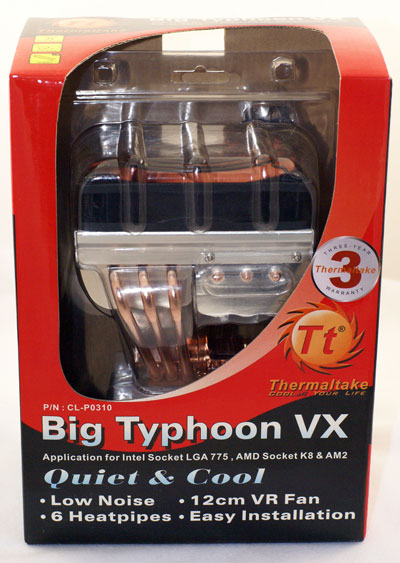
Thermaltake uses the same distinctive red and black colored packaging that is used on the MaxOrb and other Thermaltake products. The package is the same size as the MaxOrb package, but the Big Typhoon VX is a much larger cooler. The VX and a box of accessories are protected by a plastic clamshell inside the box.
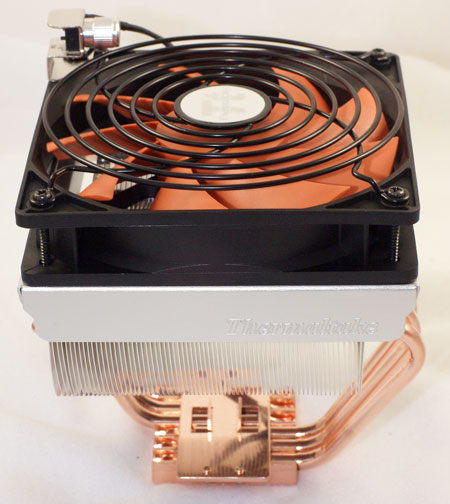
The cooler uses large vertical aluminum fins soldered to six heat pipes in a cantilever over the CPU. Cooling is provided by a 120mm fan that can be swapped for another fan if you wish. However, the VX fan has a built-in speed adjustment and can generate air flow as high as 86.5CFM at the highest speed. Noise levels are claimed to be in the range of 16dB-A on low speed to 24dB-A at high speed.
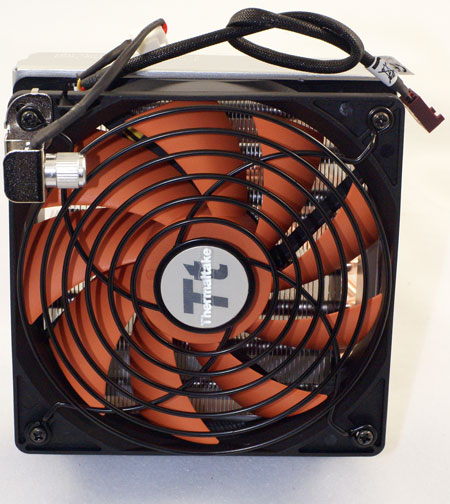
The fan is bright orange and does not contain an LED. Thermaltake uses a fan guard on the powerful fan which should provide protection for fingers that is missing on most 120mm fans.
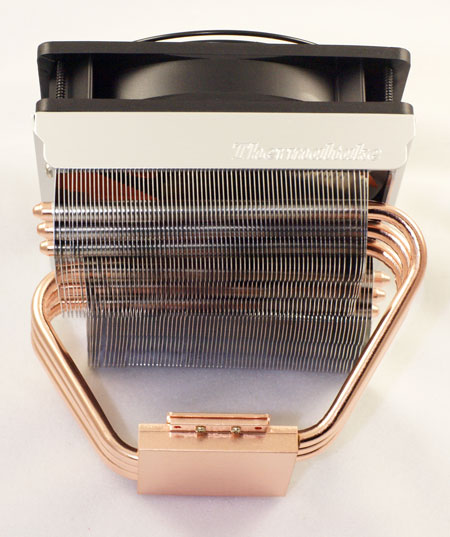
The cooling is further enhanced by six 6mm heatpipes extending from the copper base. These exit the base from opposite sides and create a very stable platform for the fin array and fan.
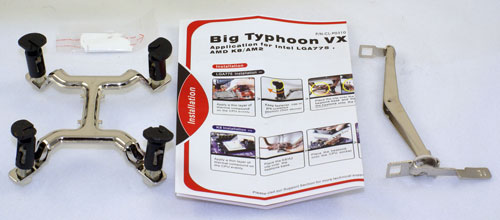
Accessories include mounting brackets for Intel socket 775 and AMD 754/939/940/AM2. Mounting of either Intel or AMD processors is very simple. The Intel 775 uses a four push-pin setup, while the AMD uses a pop-on-clip with a "turn to tighten" handle. The clip works with existing AMD/AM2 cages.
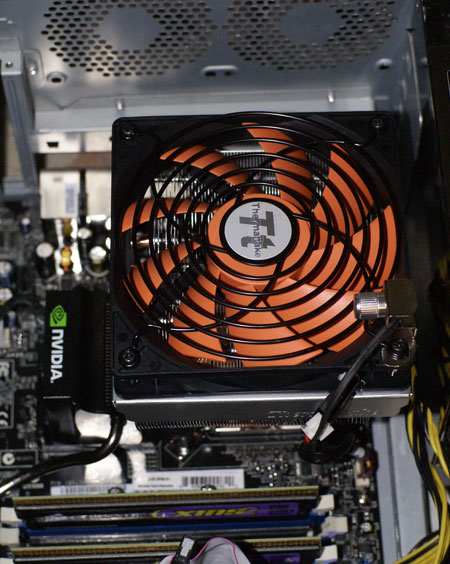
There is sufficient clearance below the fin/fan deck on the VX to make mounting possible on Intel 775 - even with the board installed in a case. You also need to be a bit of a contortionist to find a hand position that allows you to exert enough downward pressure to pop in the clips, at least on some motherboards. The only concern here is that the two-pound cooler is secured to the board with the Intel-style pop-clips. This worked fine, but this is a great deal of weight to hang off a tower mounted motherboard secured with just clips. You should be very cautious moving a mounted VX cooler if you have a tower case.
Specifications
Our test system is Intel socket 775, but the Thermaltake Big Typhoon VX will mount on any recent AMD socket as well - including 754/939/940 and AM2. All the needed hardware is provided, and installation is very easy.
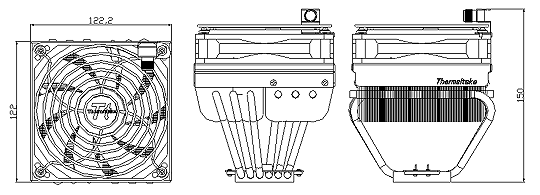
The VX is a large cooler, but it is shorter than the typical heatsink towers we have been reviewing. The EVGA 680i is a difficult to fit board due to the copper-finned heatsink and fan cooling the Northbridge. The raised deck made mounting the VX on the 680i quite simple. Installation was also an easy task on the ASUS Striker and ASUS Commando, and on the two new P35 boards - the ASUS P5K Deluxe and P5K3 Deluxe. The P5K3 Deluxe is almost a fit test for any motherboard, since the heatpipes completely circle the CPU socket and connect various cooling heatsinks around the CPU socket.
Since it was founded in 1999 Thermaltake has grown into a world-class company with a state-of-the-art testing and R&D facility based in Taiwan. Thermaltake is headquartered in Taiwan, but it has offices around the world, developing and manufacturing products like Liquid Cooling, Air Cooling, PC Enclosures and Power Supplies for every segment of the PC market. Today you will find Thermaltake cooling solutions around the world.
The Big Typhoon is a Thermaltake product that has had a long life in the marketplace. We first saw the Big Typhoon in early 2005, and at that time it was equipped with a fixed output 1300rpm fan. The VX is the latest version of Big Typhoon. The VX heatsink is identical to the original Big Typhoon with the fan changed to a variable speed (1300 - 2000rpm) with an attached fan speed control. As already mentioned the specifications for the VX fan are very similar to the specs for the MaxOrb fan.

Thermaltake uses the same distinctive red and black colored packaging that is used on the MaxOrb and other Thermaltake products. The package is the same size as the MaxOrb package, but the Big Typhoon VX is a much larger cooler. The VX and a box of accessories are protected by a plastic clamshell inside the box.

The cooler uses large vertical aluminum fins soldered to six heat pipes in a cantilever over the CPU. Cooling is provided by a 120mm fan that can be swapped for another fan if you wish. However, the VX fan has a built-in speed adjustment and can generate air flow as high as 86.5CFM at the highest speed. Noise levels are claimed to be in the range of 16dB-A on low speed to 24dB-A at high speed.

The fan is bright orange and does not contain an LED. Thermaltake uses a fan guard on the powerful fan which should provide protection for fingers that is missing on most 120mm fans.

The cooling is further enhanced by six 6mm heatpipes extending from the copper base. These exit the base from opposite sides and create a very stable platform for the fin array and fan.

Accessories include mounting brackets for Intel socket 775 and AMD 754/939/940/AM2. Mounting of either Intel or AMD processors is very simple. The Intel 775 uses a four push-pin setup, while the AMD uses a pop-on-clip with a "turn to tighten" handle. The clip works with existing AMD/AM2 cages.

There is sufficient clearance below the fin/fan deck on the VX to make mounting possible on Intel 775 - even with the board installed in a case. You also need to be a bit of a contortionist to find a hand position that allows you to exert enough downward pressure to pop in the clips, at least on some motherboards. The only concern here is that the two-pound cooler is secured to the board with the Intel-style pop-clips. This worked fine, but this is a great deal of weight to hang off a tower mounted motherboard secured with just clips. You should be very cautious moving a mounted VX cooler if you have a tower case.
Specifications
Our test system is Intel socket 775, but the Thermaltake Big Typhoon VX will mount on any recent AMD socket as well - including 754/939/940 and AM2. All the needed hardware is provided, and installation is very easy.

| Thermaltake MaxOrb Specifications | ||||
| Heatsink | ||||
| Dimensions | 122(L) X 122(D) X 103(H)mm | |||
| Weight | 827g (including fan) | |||
| Material | Pure Copper Base and Aluminum Fins | |||
| Heatpipes | Six 6mm copper heatpipes | |||
| Fan | ||||
| Fan Size | 120 mm x 25mm | |||
| Bearing Type | Sleeve Bearing | |||
| Fan Life | 30,000 hours | |||
| Connector | 3-pin with integral fan-speed rheostat, 3.0 Watt Input | |||
| Speed | Lo Speed | 1,300rpm | Hi Speed | 2,000rpm |
| Noise Level | Lo Speed | 16.0dBA | Hi Speed | 24.0dBA |
| Fan Output | Lo Speed | - | Hi Speed | 86.5cfm |
The VX is a large cooler, but it is shorter than the typical heatsink towers we have been reviewing. The EVGA 680i is a difficult to fit board due to the copper-finned heatsink and fan cooling the Northbridge. The raised deck made mounting the VX on the 680i quite simple. Installation was also an easy task on the ASUS Striker and ASUS Commando, and on the two new P35 boards - the ASUS P5K Deluxe and P5K3 Deluxe. The P5K3 Deluxe is almost a fit test for any motherboard, since the heatpipes completely circle the CPU socket and connect various cooling heatsinks around the CPU socket.










34 Comments
View All Comments
rjm55 - Thursday, June 7, 2007 - link
Maybe the real point is that those who bought these down-fan coolers for better cooling are just disappointed to find out they don't work as well as the top guns.stepone - Thursday, June 7, 2007 - link
The point I was making was that the 120 VX (& down blowers inparticular) benefit more from exhaust fans than tower coolers do and a proper case setup will nearly always include at least 1 120mm extraction fan.Seriously who buys an after market HSF & then uses no case fans (HTPC users maybe but most HSF units will be 2 big for those cases)?
As for your sour grapes implication, you're being very close minded...
Is it not possible that other people's opinions & real world experience of the 120 VX could be different & that they're trying to simply get people to take a 2nd look at this HSF instead of being petty individuals in a vindictive jealous rage trying to steer others to the same mistake?
As for Anand techs dissing of Hexus's tests this doesn't seem fair.
Sure they used a different testing methodology than yours but that doesn't make their results worthless and although I disagree with some of their methodology as well it doesn't negate their results. Just as it doesn't negate yours.
To me these 2 reviews make it clear that a case with good ventilation & 2-3 fans will benefit the 120 VX more than a tower cooler & perhaps skew you in that direction but cases with 1 or no fans should go with a tower cooler for better results.
And yes I am happy to seed the crown of best HSF to the Ultra 120 as I do believe it is the best around at the moment. I just believe that the 120VX is a better cooler in real world cases then you give it credit for as your test setup does not reflect the type of system setup that most people will be using in their PC's.
Still good job Anand Tech for providing a review at all.
Thanks... (boy that was way too long :-)
rjm55 - Thursday, June 7, 2007 - link
Am I dense? If the down facing fan coolers need case fans to approach cooling as well as the towers with side fans isn't this proof the towers cool better?It is also interesting that Wesley found the down fans and side fan models both benefited from adding a case fan. So what's the point?
DaveLessnau - Thursday, June 7, 2007 - link
As I mentioned in your last heatsink review, it's because you don't have a case fan. All you're doing with the down-facing fan on this heatsink is circulating the same hot air around and around the case. All it does (all it CAN do) is get hotter. No one in their right mind would run a computer without at least one case fan, ESPECIALLY when over-clocking. In this artificial (and incorrect) test environment you've created, those side-blowing heatsink have a definite advantage since they can force some hot air out through that empty case fan slot.
I realize you did this test in the same environment as the last one so you could compare apples to apples. But, there's no point in a proper comparison across tests when the tests themselves are faulty. Put the case fan back in your test bed and at least re-test one down-blowing and one side-blowing heatsink.
Wesley Fink - Thursday, June 7, 2007 - link
Our current case does have a PS fan that removes hot air from the top of the case and rear vents to exhaust rear air, but no case fans. All coolers were tested under these consditions.We did test 2 of the down-facing coolers with a rear case fan installed. Cooling performance was improved a few degrees, but overclock remained about the same. We then tried the rear case fan with two of the heatpipe towers. Cooling performace was also improved using a case fan on the heatpipe towers but overclock was almost the same. We suspect that if we were testing with much lower output fans the case fan would make more of a difference.
In the end we would need to retest all coolers with a case fan installed, not just the down-facers. Right now we doubt it would reveal more than we already know, based on quickly checking 4 coolers with a case fan.
Our new test bed will include a "quieter" variable speed PS with a different fan configuration. We will also include a large low-rpm case fan. We do plan to retest a cross-section of the coolers for new baseline results when the new cooler test bed is finalized and updated.
Martimus - Thursday, June 7, 2007 - link
I know that I have written in both of the previous reviews that blowing the hot air back onto the component is counterproductive, and that turing the fan around would help that part at least. But, the side blowing fan is just a better design. It has better airflow, and doesn't end up with the turbulence and back pressure that a downward facing fan has. Side blowing fans aren't always practical though, because they stick out much farther, and cause much more strain on the motherboard.strikeback03 - Thursday, June 7, 2007 - link
The height of the VX is 150mm, including the control knob on top, so say 135mm for the top of the fan. Most of the weight is far away from the motherboard. The Tuniqstrikeback03 - Thursday, June 7, 2007 - link
typo submitted the comment unfinished.The Tuniq is 155mm tall and the Thermalrights 160.5, and I would not be surprised if they put less of a moment on the motherboard due to the mass not being all concentrated at the far end.
Bull Dog - Thursday, June 7, 2007 - link
Very nice review. I love the dig at Hexus at the end. Their review really did piss me off in the fact that they used such a crappy fan on their Ultra-120.jkostans - Thursday, June 7, 2007 - link
I agree, this review is 10x better than the Hexus one. The Hexus review was a slap in the face to legit reviews.